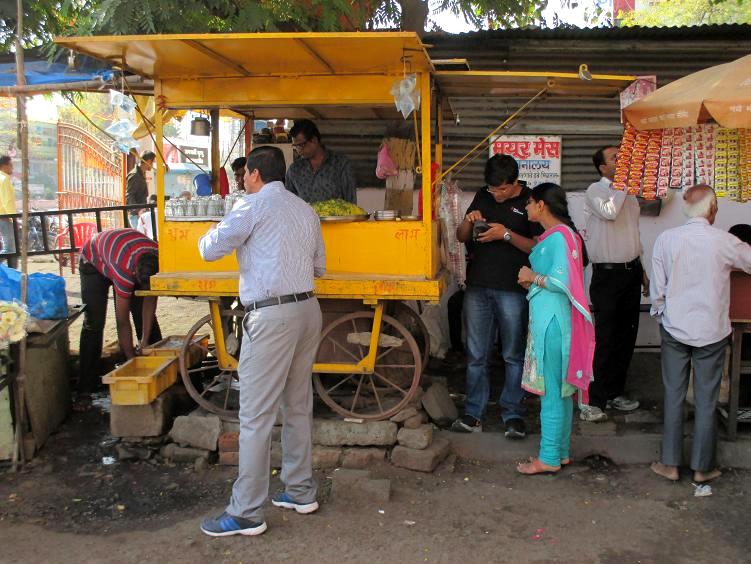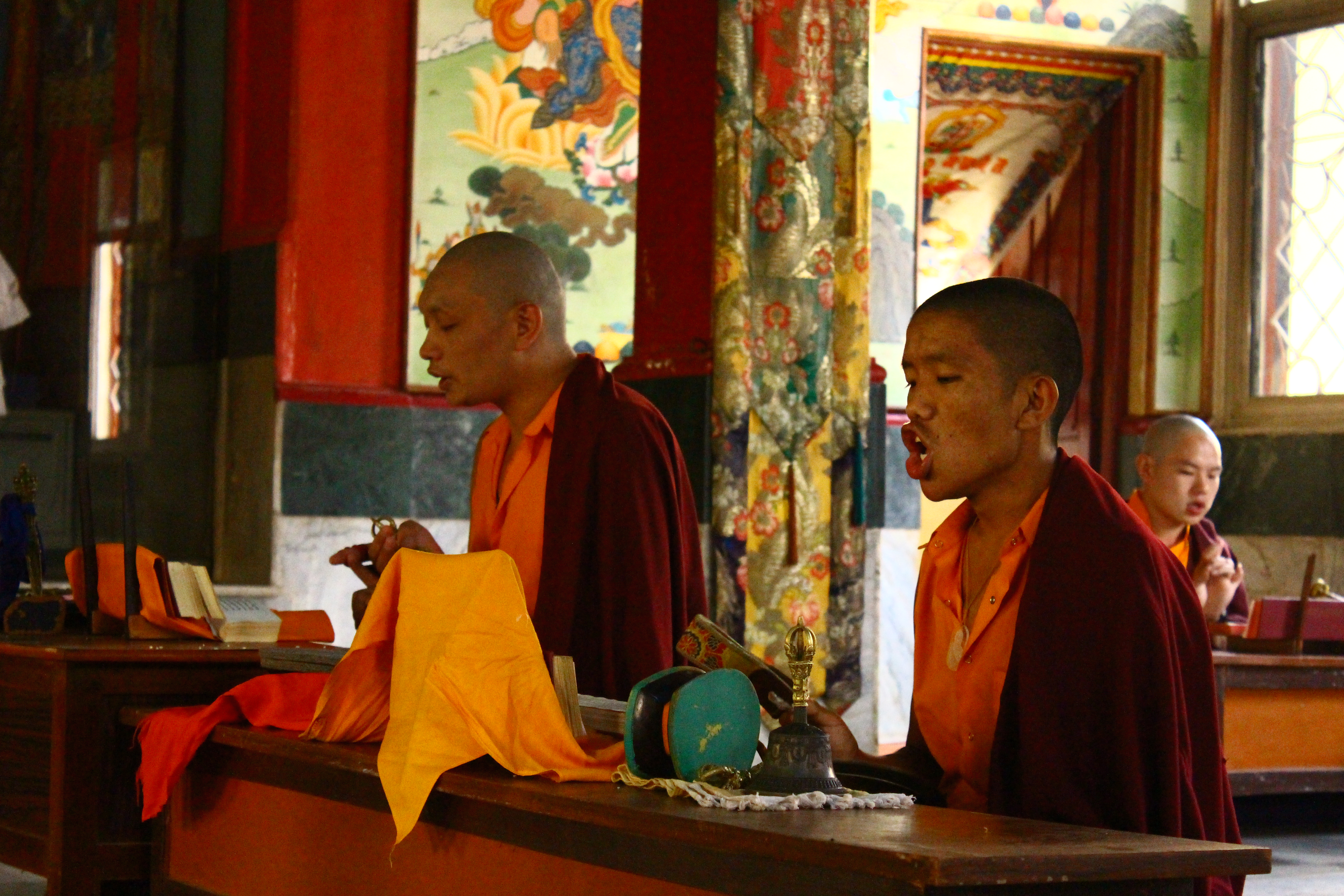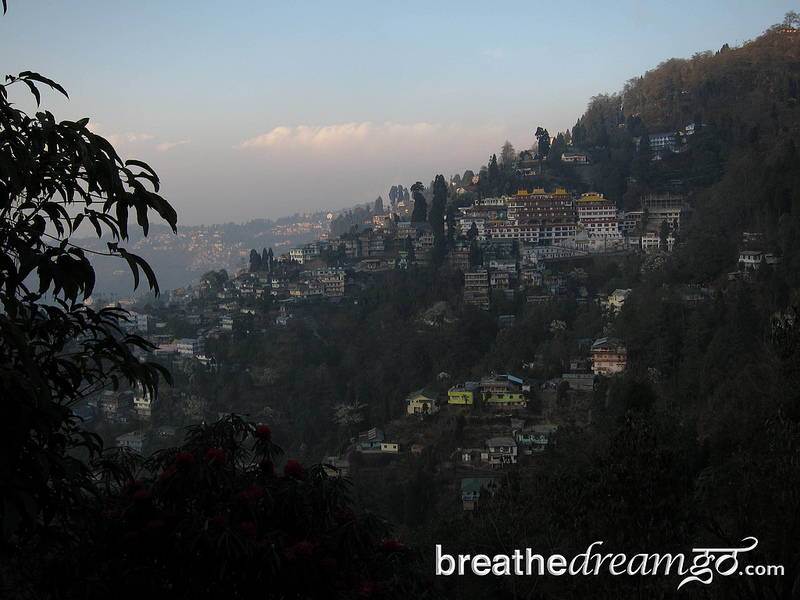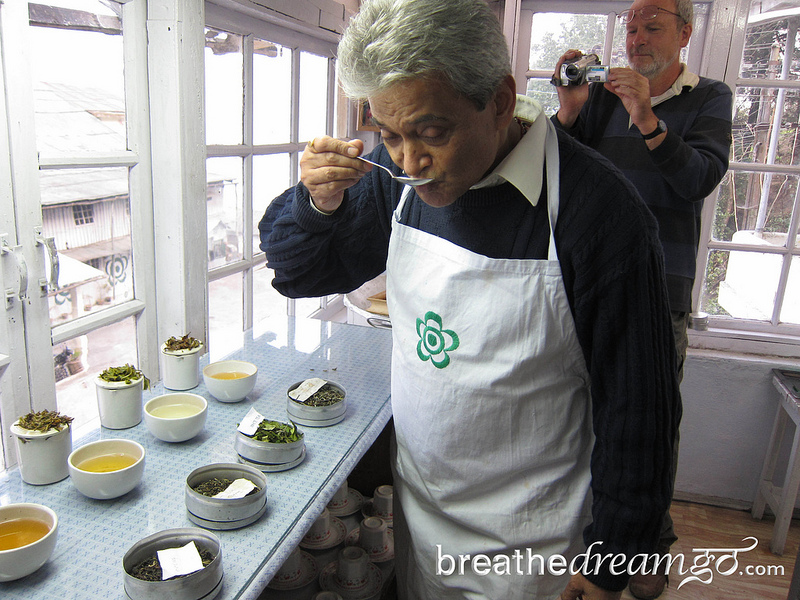Outside the Sai Baba temple in Nagpur, Maharashtra, Raju Ninawe serves piping hot poha and chai to devotees and passersby. Ravindra Bhalerao recalls Ninawe’s story and hopes for the future.
For twenty long years Raju Kaka has watched the crowds that throng the Sai Baba temple in Nagpur: pilgrims and devotees, some young, others old, all dressed in colourful attire and eager to bow down in reverence before the Baba. These folks come from all over the city and its neighbouring areas; some of them come only occasionally, while others are regular visitors who find time to drop in at the temple each week, maybe more often. Raju Ninawe, the chai wallah, has his perch next to this revered place of worship. And these people are his friends; he owes his livelihood to these folks who throng the place, as he does to the ‘regulars’ who congregate at the benches laid out beside his stall.
Lest anyone should imagine that Ninawe is the solitary chai wallah offering refreshments next to the temple, let me say that his cart is only one among a whole line of stalls that line the tiny street adjoining the temple. There are paan wallahs and florists selling garlands, there are women selling coconuts and various sundries that the devotee needs for his ritual. And there is the occasional fruit-seller, the mumfalli wallah, and the kulfi wallah too. Worship and commerce thrive here side by side, as they have always done.

Ninawe’s tea stall
But it is Ninawe whose fortunes seem to us worthy of record. An old hand at brewing tea, Ninawe has a stall painted a breathtaking yellow shade. If you are hungry, he does not have much to offer besides fried rice—but then it is rice with a difference. It is ‘poha’, a much loved item on the breakfast table here in Central India. So then if you are famished, Ninawe is going to treat you to a plateful of poha garnished with coriander and sev and served up with appetising gravy. He will also treat you to tea: rich, strong tea flavoured with ginger or cardamom, whichever you please. Tea has been his life, his very breath; he has brewed it ever since he was ten.
Bespectacled and with his hair combed neatly back, Raju Ninawe is the chai wallah who takes pride in his work. You can see the twinkle in his eye when he tells us of a time when a leading Marathi television channel had filmed a documentary in this area and went on to include a brief shot of his tea stall next to the temple. And going even further back, he tells us of a time when he worked at a tea stall next to the home of Muttemwar, a local politician. The late Mr. Rajiv Gandhi, yet to enter politics at the time, was to pass through Nagpur and hoped to meet Muttemwar briefly as he passed through town. It was in the early hours of the morning while it was yet dark that Mr. Gandhi arrived by car and halted by the roadside to have a word with Muttemwar. Ninawe, who had been instructed beforehand, stood prepared with kettle and cups, and went on to serve a morning cup of tea to Mr. Gandhi and others in the company. It was a grand occasion, a rare privilege for the young man, an event which he recounts with a good deal of warmth and gusto.
Raju Kaka is only too eager to share tales from his childhood days. Like many others of his line, he grew up amidst appalling poverty, we are told. “I grew up in the Sitabuldi area of Nagpur close to Shree Talkies. My childhood was far from being memorable; it was more like a nightmare for I was more or less an orphan,” he says with a tinge of regret. But the young boy was not an orphan in the strict sense of the word. Ninawe lost his father, a rickshawallah, when he was only an infant. As the lad grew up, his mother, a construction worker, began to find it increasingly difficult to cope with her son’s erratic behaviour. Consequently the boy was sent away to live with his grandmother. It was hoped that this would effect a change in the boy’s temperament, but things only seemed to get worse. And so at the young age of ten, Ninawe found himself on the streets with only one set of clothes and not a penny in his pocket.
It was this period in his life that shaped the boy’s career. He had attended school before, but went only as far as Class II. Education was clearly out of the question. Young Raju now found employment as an assistant to a tea vendor in Netaji Market. As a tea stall boy, he was paid around Rs 150 a month. The work was simple enough: stirring tea, carrying around trays laden with cups, washing up, while all the while learning the art of brewing by watching his superior at work. There was nothing particularly difficult about the job. But it would keep him on the run from morning till night.
Having begun life on this tragic note, one might think the boy might be spared of any further disappointments along the way, but things proved to be otherwise. Barely had a year passed after he had set out on his own when his mother died. The boy continued at the tea stall, later moving on to Dhamangaon where he stayed for a while with an uncle tending to goats and selling bread. His boyhood was one long battle to earn his bread and win social acceptance. Recalling his past, Ninawe tells us that he tried his hand at anything that came his way during those days. “As I grew up, I worked in petrol pumps, as a labourer, as a chowkidar, and in kirana shops. With the exception of stealing, I have tried my hand at everything; I even begged for a while,” we are told.
But then circumstances would bring him back to the streets of Nagpur, back again to the job of an assistant at a tea stall. It was with tea that he had begun life, and it was to the tea stall that he looked with hope. The kettle and the cup beckoned to him; he would live in the great outdoors, pumping up the Primus, grinding up ginger and cardamom, pouring out the brew, serving up cups. These were the things he excelled in, the things that really mattered. This was the stuff life was made up of.

Ninawe at work
Speak to the man behind the wheel of a lorry on the highway and he will tell you he dreams of the day when he will own his own truck. The chai wallah’s assistant likewise dreams of the day when he will own his own stall. The turning point in Ninawe’s career came when he was working at Ajni Square. He was 28 years old at this time with a wife and kids at home, and paid a sum of Rs 450 each month from his earnings to the owner of the cart. Then one day a friend named Lohikar turned up offering to sell him his tea stall next to the Sai Baba temple on Wardha Road. Ninawe’s joy knew no bounds and for a sum of Rs 5000 he bought the thela from his friend. The whole thing took place without a hitch, unannounced, and without any effort on his part, and Ninawe believes it could only have been an act of Providence. Henceforth, he would no longer be an assistant; he was a full-fledged chai wallah with his very own 4-wheeled stall!
For twenty long years Raju Kaka has worked at his stall brewing tea. “When I first began here at the Sai Mandir, I offered poha, aloo-bonda and puri-bhaji besides chai,” he tells us. Today the fashionable Krishnum Restaurant nearby beckons to the visitor offering a menu as dainty and variegated as the colourful folks seen arriving at the spot. Ninawe’s own menu has seen a corresponding decline; he has only poha to offer besides tea these days. But this has not affected his business in an adverse way. While Krishnum may lure away the fashionable and the rich, Ninawe’s tea stall is still the best place for homely fare savoured amid a rustic setting. Even womenfolk and young ladies stop by his cart for a quick bite and a glass of ginger tea before moving on.
Ninawe runs his tea stall six days a week taking a holiday on Mondays. He arrives in the morning at around 8 o’clock bringing along with him four kilograms of poha, and a rich, spicy gravy containing chhole, both cooked in the home. Most people who drop in for poha order half a plate which costs Rs 15, and is served with a garnishing of gravy, sev, and finely chopped onion and coriander. A full plate of the same dish would be charged at Rs 25. A glass of ginger or elaichi tea is priced at Rs 6 (without milk it is Rs 5), while packaged drinking water costs Rs 3 per pouch.

Over the years the numbers visiting the Sai temple in Nagpur have grown beyond reckoning, and Ninawe’s sales have boomed. “I easily make Rs 500 to 800 each day, even more,” he points out with a feeling of pride. On Thursdays the temple draws visitors in thousands to celebrate Baba ka din, and Ninawe’s sales reach a peak. At such times he may even earn as much as Rs 1500 in a single day. The family lives in Juni Ajni where his wife runs a mess from her home. With income coming in from both sides, Ninawe is no longer the chai wallah dressed in rags. He arrives for work on a Bajaj scooter, he has two sons, one studying in an Industrial Training Institute, and pays a rent of Rs 5000 each month for his home. Gaurav, his elder son, is the proud owner of a mobile phone working on the Android system.
People dropping into Ninawe’s tea stall range from casual passersby who stop by for a chai, to devotees arriving at the temple seeking the blessings of the Baba. You will find youths from the neighbourhood seated at the bench engaged in endless dreamy talk on a variety of topics. And you have shopkeepers in the vicinity who are regular customers buying on monthly credit. Ninawe, who can read and write Hindi, tells me that no one can cheat him here as he enters all credit transactions in a register he maintains especially for the purpose.
Raju Kaka’s tea stall is set in a location that at once presents to the viewer a glimpse into both sophisticated and genteel living and the rustic charm of a wayside inn. One only has to take a seat at Kakaji’s bench under the lights in the evening before he begins to see that both worlds co-exist here side by side. Across the street is a modern, up-to-date block where may be found a watchmaker, a doctor’s clinic, a pizza center, garment stores, and Krishnum. In Krishnum’s courtyard may be seen row upon row of parked scooterettes, and every now and again one may see a young lady in salwar-kameez, very coy and demure, escorted by her beau, having a tete-a-tete. Nothing wrong in that. The restaurant draws mostly families from respectable homes and towards evening after it has grown dark, gentlemen dressed in their evening best may be seen moving down the steps leading to the restaurant with their ladies, all daintily done up, phantom figures in diaphanous sarees moving dreamily down the steps with plump, prettily dressed children in tow.
Ninawe has his tea stall facing Krishnum, next to the paan shops, lottery centres, tea stalls, florists and rows of beggars who arrive each day. This is the hangout of young bucks, street corner loungers, the man who has had a peg too many, and brash ladies who have enough pluck to step into this not-so-respectable male domain and emerge unscathed.
“A tea stall is a place where people talk about almost everything under the sun,” Raju Kaka tells me as I sip a glass of ginger tea beside his stall. As if to make himself clearly understood, he adds, “… everything from business plans to latest fashions, jilted love, vendetta, girls….” At this point I interjected and asked him if he had anything to offer by way of advice to budding young chai wallahs today. But Ninawe was silent on this issue. “One good thing about a chai stall is that you can begin one without any prior experience,” he said philosophically. Which is of course true; all one needs is a small outlay of capital to buy a thela, glasses, kettle and stove to begin. But what about the lads who may be seen at chai stalls ferrying trays of cups to customers around—don’t these unfortunate boys deserve our sympathy? “Oh, no one treats them with much respect,” Ninawe tells me. “Someone may yell out to a chhokra saying get me a cup of chai, you @#*&$%…” Ninawe himself has gone through it all and is well acquainted with the trials along the way. And by now he is used to it.
As I put my glass down, two college youths arrive on a motorbike. “Kyon Kakaji, aaj bahut young lag rahe ho?” said one striding into the place with a grin. (“Kakaji, why do you look so young today?”) Ninawe, now 46, is pleased with the comment. The other boy, looking like a Hindi film villain, seems equally pleased, but is in no mood to pay compliments. “Abbe @#$%*&, chal do cup chai la…!” he orders, a roguish smile on his lips.
And thus Raju Ninawe the chai wallah works on, remaining at his stall from 9 o’ clock in the morning til 9 in the night. His sons, Gaurav and Mayur, may be often seen at the spot helping their father with his work. Does he have any plans for the future? “I have no plans, for I am satisfied with my work,” says Ninawe in reply. Yet he would not like his sons to follow in his footsteps. “Gaurav, my elder son, is studying in an ITI and takes part in sports and athletics; I would like him to join railway service.”

Ninawe and his son work together
But won’t he like to graduate to a larger, more lucrative business? “I did have plans to set up a restaurant, but did not have the money for it,” Ninawe says. He still feels an urge to learn English and when a message arrives on his cellphone, he tries his best to decipher its meaning. “I would have liked to get an education, but that was denied to me,” he says.
Despite these setbacks, Ninawe has few regrets in life. “My only disappointment is that I still live in a rented home,” he tells us. He has no plans for himself; all he wants is to see his family happy, his sons settled well in life. His own childhood had been eked out in misery and he would not like anyone else to go that way. Looking back over bygone days he can still feel the pain of a childhood deprived of love. “Back then I was only a chhokra dressed in half-pants, always begging for things,” he recalls. “And those around me who were more fortunate brushed me aside as though I were filth. Today those very people come to me with awe and respect.”
And what does he do, when these folks come round? “I don’t wish to have anything to do with these people. I merely fold my hands in a namaste and go my way.”






























